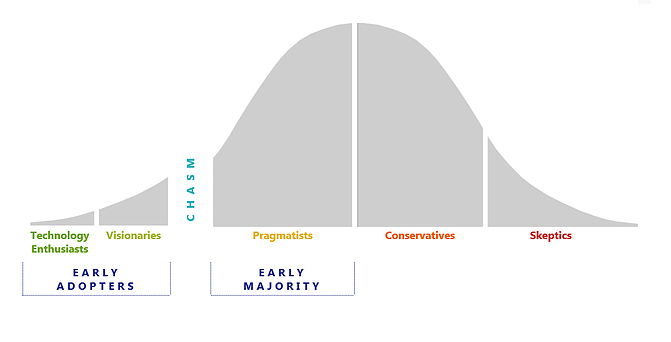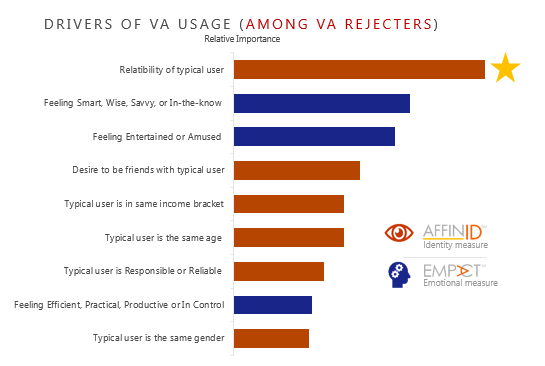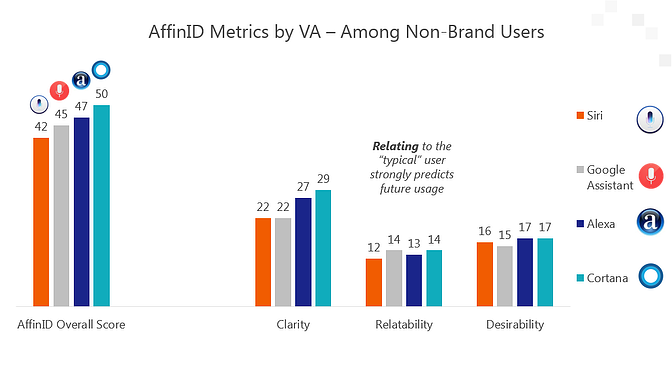It’s about a 4 min. read.

Every nascent technology and every tech start-up faces the same marketing challenge of “crossing the chasm” into mainstream adoption. Geoffrey Moore framed this very well in his 1991 classic, “Crossing the Chasm”:

Word of mouth can play a huge role in motivating certain segments to sip the Kool-Aid and make the leap.
With CES 2018—the world’s largest gadget tradeshow—happening in Vegas this week, I can’t help but wonder if mainstream consumers don’t relate to the early adopters of new technology? What if they think it’s used by people who aren’t part of “their tribe”? Will it prevent them even considering the new tech? There are countless technology categories that have faced this challenge, for example:
I hypothesized that the virtual assistant (VA) category—and specific brands within it—faces this challenge. Yes, many people have tried and used Siri, but few mainstream consumers are truly using virtual assistants for anything beyond basic hands-free web-queries. To further complicate things, an increasing number of “smart home” products that connect to intelligent wireless speakers in the home (e.g., Amazon Alexa, Google Home, Apple’s forthcoming HomePod) are proving divisive. Some people love the experience or the idea of commanding a smart device while others categorically reject the concept.
My team and I had the chance to test out a few hypotheses through our Consumer Pulse program and —voila!—we’ve got some tasty (and useful) morsels to share with you about how social identity is influencing consumer adoption in the virtual assistant space using our proprietary AffinIDSM solution.
Here’s what we found:
We studied US consumers (18+)—covering usage, adoption, and perceptions of the virtual assistant category and a deep-dive on four major brands within it: Apple’s Siri, Amazon Alexa, Google Assistant, and Cortana by Microsoft. We covered rational perceptions of the category, emotional reactions to experiences using virtual assistants, and perceptions of the “typical” user of Siri, Alexa, Google Assistant, and Cortana.
We then ran fancy math™ on our data to create a model to predict the likelihood of a virtual assistant “category rejecter” (i.e., someone who has never tried a VA before) to try any one of those assistants in the future. Our analysis indicates that how much a current VA category rejecter relates to their image of the type of person who uses a virtual assistant is the number one predictor of whether they are likely to try the technology in the future:


As the chart indicates, relatability (the biggest predictor of likelihood to try as shown previously) scores the lowest of the three components of AffinID: relatability, clarity, and desirability. You may ask yourself: “are scores of 12 to 14 ‘good’ or ‘bad’? They’re bad: trust me. We’ve now run AffinID on hundreds of brands across dozens of industries, so we have a formidable normative database against which to compare brands. The VA category does not fare well on “relatability,” and it matters.
Some brands’ VA ads, while amusing, are not very relatable to “normal” mainstream consumers. For example, as my colleague Erica Carranza points out in her recent blog, Siri’s ad featuring Dwayne “The Rock” Johnson doing impossibly awesome things in one day (including taking a selfie from outer-space) with the help of Siri isn’t exactly a “normal” person’s day. A-grade for amusement on this one, but it is playing into an existing perception problem.
The age gap between rejecters and “typical” virtual assistant users is a social identity construct keeping rejecters out of the category. Current rejecters, not surprisingly, skew older while current heavy VA users, also not surprisingly, skew young.
We uncovered this disconnect with a big predictive model using “match analysis” on a variety of demographic, personality, and interest attributes. For every attribute, we examined whether there was a “match” or a “disconnect” between how a rejecter described themselves vs. how they perceived the typical user of a virtual assistant brand.
The two specific perceptions that had the greatest ability to predict a rejecter’s likelihood to consider using a brand in the future were an age-range match and an income-range match. For example, if I’m over 35 years old (hypothetically!), and I perceive the “typical” user to be under 35 years old and higher-income than me…so what? Well, it does matter. For new technologies to achieve mainstream adoption, they must debunk the widespread perceptions that the early adopter is “young” and highly affluent, and that their product can be used by everyone (think: Facebook). SNL pokes fun at this generational discrepancy.
But in all seriousness, if a virtual assistant brand wants to achieve more mainstream adoption among older demographics, the brand gurus and creative teams working on campaigns need to tackle this head-on.
And they must try to do this—ideally—without alienating the original early adopter group that made them their first million (think: Facebook, again…how many Gen Zers do you know who actually use it actively?). I—prototypical 45-year-old suburban dad—can’t imagine using Snapchat, for instance. If Snapchat wanted to get me and my tribe to buy in as avid users*, it needs to convince me that Snapchat isn’t just for teens and early twenty-somethings. Or it needs to launch a different brand/product targeted specifically at my tribe and market it appropriately.
It’s worth noting there are other social identity constructs that help predict whether a non-user of a virtual assistant is likely to try a product in the future. For instance, the few VA category rejecters who perceive the typical (young, affluent) user as being as “responsible/reliable” as themselves are more open to trying a VA in the future than those who do not perceive VA users this way. So, we’re seeing this stereotype that virtual assistant products are for young, affluent professionals living in a major coastal city with no kids to contend with yet, and this is turning some consumer segments off from trying out the category in earnest.
Stay tuned to this channel for more on our study of the virtual assistant category. I’ll be covering some key insights we got by applying our emotional impact analysis—EMPACT℠ to the same issue of what virtual assistant brands should be doing to achieve further adoption and more mainstream usage of their products.
*I am more than 95% confident that the Snapchat brand gurus do not want me as an avid user…and my ‘tween daughter would definitely die of embarrassment if I ever joined that particular platform and tried to communicate with her that way.